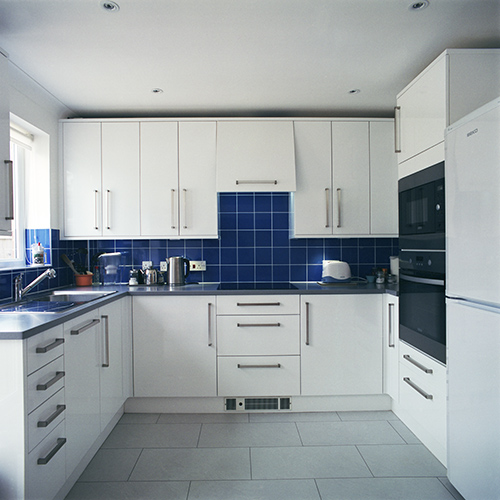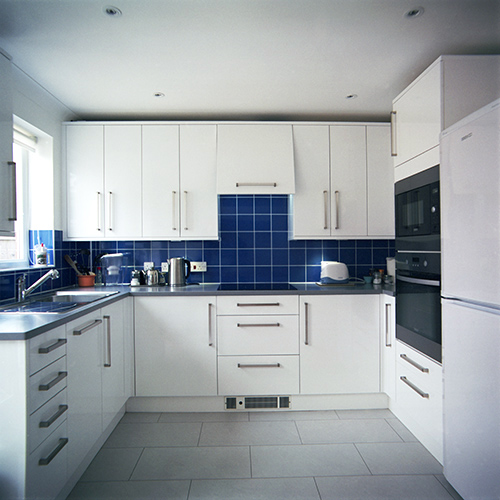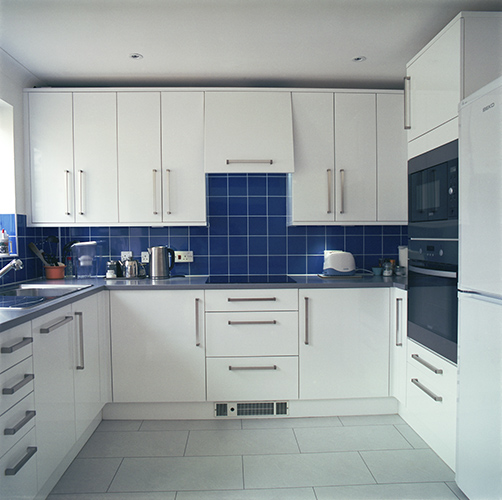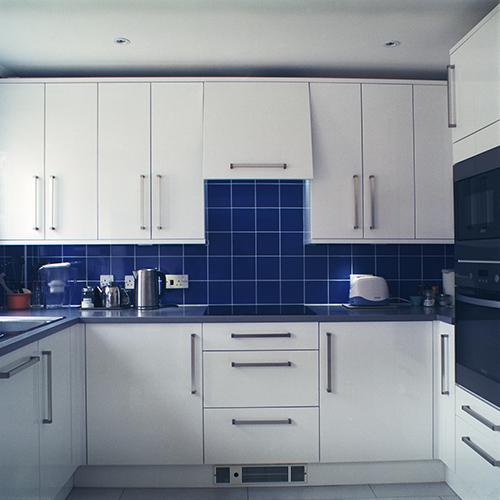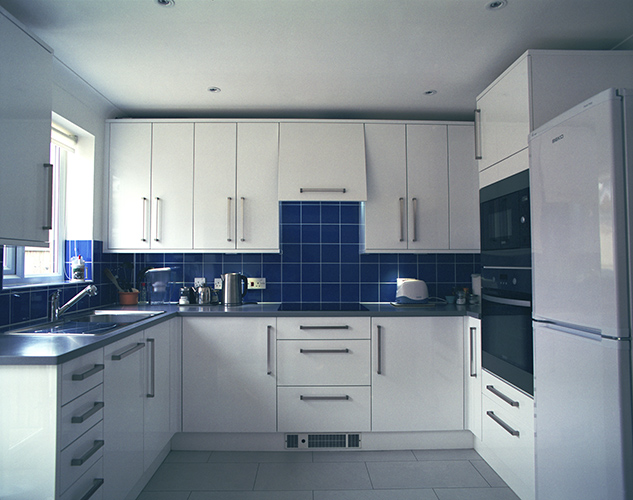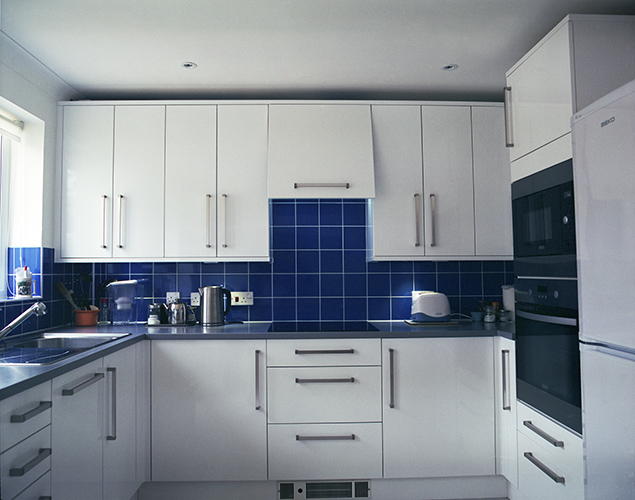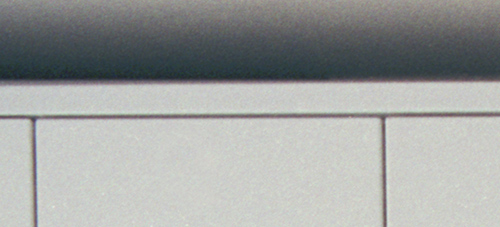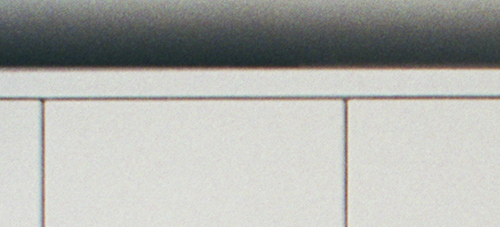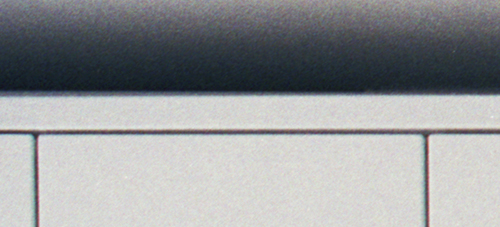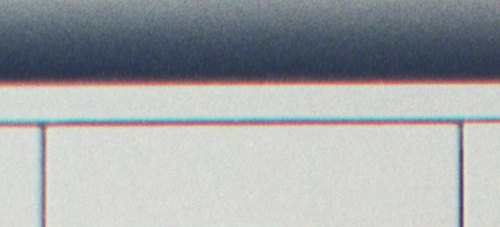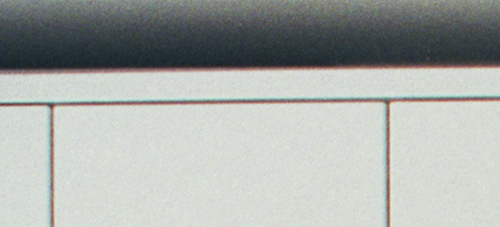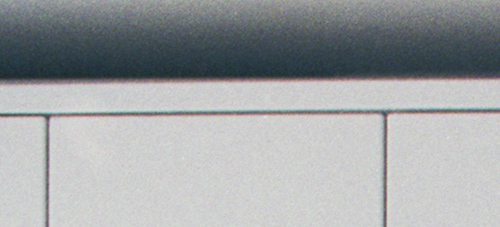by TRA
Pentax 6×7
lens test Results
Tests of Wide Angle lenses:
coverage, linear distortion, chromatic aberrations,
sharpness and contrast
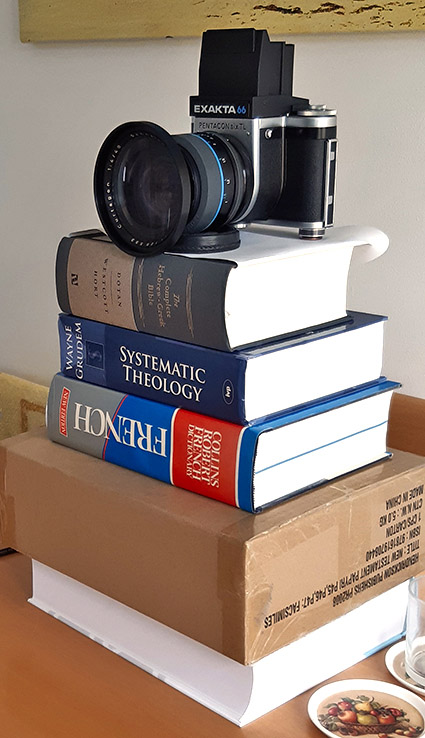 [WA_test_setup_01.jpg]
|
|
One important area of
use for wide angle lenses is for shots of
interiors of buildings. We have therefore
here carried out tests in a domestic
kitchen. The profusion of straight lines in
the subject will be a good test of how good the
lenses are at rectilinear reproduction. In
other words, are straight lines in the subject
reproduced as straight lines on the film?
This is a very tough test for wide-angle lenses,
and for the wide-angle end of zoom lenses, which
often display barrel distortion. For this test we wanted to get the camera as near to the opposite wall as possible. This made using a tripod not practical, so the cameras were raised to the appropriate height by a stack of books placed on the kitchen table. The proximity to the wall also prevented us from getting behind the camera to compose the image, so we used the best waist-level finder that fits the Pentacon Six, the Exakta 66 finder. Film in both cameras was Fuji Fujicolor Professional PRO160NS. Before starting the session, a meter reading was taken, using the Pentacon TTL metering pentaprism on the Pentacon Six. This reading, 1/30th second at f/8, was used for all photographs taken during the session on both cameras. In the image on the left, the 40mm Schneider-Kreuznach Curtagon for the Exakta 66 can be seen mounted on the Pentacon Six. For more information on that lens, see here. In the image on the right, the 45mm Pentax 67 lens is mounted on a Pentax 67II, on which we have mounted the Pentax 67 waist-level finder. We will here compare lenses for the Pentacon Six / Exakta 66 / Kiev 60 with two Pentax 67 wide angle lenses on the Pentacon Six. We will then compare the coverage on the Pentacon Six when the same Pentax 67 lenses are used on a Pentax 67. The distance from the focal plane of each camera to the centre of the subject was measured with a metal measure and set on all lenses at approximately 3.4 metres. |
|
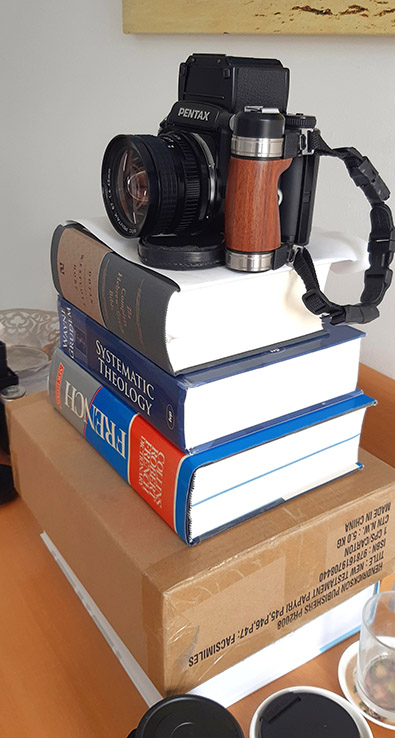 [WA_test_setup_02.jpg]
|
Lighting
Note that these images were not taken in a photographic studio but in a domestic environment, such as may be encountered by many visitors to this page. Lighting intensity and colour are therefore not uniform across the whole image area. There are two main sources of light:
1. Daylight
This enters the image from a window to the left that is partly visible is some of the wider-angle images and also from a full-length glass door also to the left, closer to the camera and not visible in any of the images.
There is a significant fall-off in light intensity from left to right, and the colour balance of the light also changes from left to right, being cooler (bluer) on the left and warmer to the right. The fall-off in light intensity on the right-hand side of the images also means that any slight variations in colour between one photograph and another are easier to see. These variations are more probably due to the manipulation processes involved when scanning the images and adjusting brightness, contrast and colour on the computer.
The intensity of the daylight and its colour also changed slightly throughout the session, as clouds moved over an otherwise blue sky.
2. Artificial light
This comes from the downlighters in the extractor hood and under the wall units. Although these are described by the manufacturers as “cool”, they do not have the same colour temperature as the prevailing daylight, being somewhat “warmer” than daylight (with a greater yellow/red component). Their intensity is much lower than the prevailing daylight, so they do not have a significant impact on the colour of the images.
In “real life”, one is unlikely to take in the region of a dozen images of the same subject, each with a different lens, and all of these lenses produce images of a colour and contrast that are very good, so any variations in colour and contrast with all of these lenses are insignificant for most pictures.
On this page,
clicking on each image opens a larger version of the
image. With most browsers, a second click will
enlarge the image further, except in the case of the
small images of chromatic aberrations at the bottom
of the page, which will probably only enlarge once.
Comparing coverage
2 × 40mm
| |
40mm Bronica
Zenzanon (see details of this lens here)
[C582_1-2_40mm_Zs.jpg]
|
Note that the shadow
in the bottom left corner of these two images is not
(principally!) vignetting (darkening of the
corners of the images); it is the shadow of a
pedal bin that is just out of the shot. Likewise, the shadow in the top left corner is a shadow on the ceiling from a wall unit, the door handle of which can just be seen. The top of this unit nearly reaches the ceiling. On the right of the image, the closeness to the ceiling of the top of the tall right-hand “tower” unit containing the two ovens also darkens the ceiling in the top-right corner. This leaves the bottom right-hand corner, the bottom door of the fridge-freezer, where the darkening is no doubt a combination of the light distribution from the window and some vignetting by both lenses. However, the contribution of these two lenses to the darkening of the corners of the images is relatively minor and substantially less than one might believe just by looking at these two pictures without considering the other contributing factors. |
40mm
Schneider-Kreuznach Curtagon (for details of
this lens, see the link above)
[C582_3_40mm_Cs.jpg]
|
|
3 × 45mm
| The first
two images here are “Soviet” era lenses from
Arsenal in Ukraine. The 45mm MC Arsat B lens
on the left is a rare multi-coated post-USSR
version of the commonly-found 45mm Mir 26Б
wide-angle lens. The middle image is from the extremely rare Mir 69Б lens, which is much more compact than the earlier Mir 26Б. The image on the right was taken with a Pentax 67 45mm lens mounted onto the Pentacon Six. Unsurprisingly, the image coverage with the Pentax 45mm lens for 6×7 format is better on the Pentacon Six than with the two 45mm lenses that were designed to cover just 6×6, with far less brightness reduction particularly visible in the top left corner of these three images. |
|
45mm Mir
69Б For more information on this lens, see
here.
[C582_6_45mm_69Bs.jpg]
|
|
45mm Pentax 67
lens For more information on this lens,
see here.
[C582_12_45mm_Px67_lenss.jpg]
|
|
50mm & 2 × 55mm
| Three
lenses, three different manufacturers. First (on the left), the Carl Zeiss Jena 50mm Flektogon designed for the Pentacon Six. Second (in the middle), the post Soviet-era Arsat 55mm shift lens, here in zero shift position. Third (on the right), the Pentax 67 55-100mm zoom lens at its widest setting, 55mm. |
50mm Carl Zeiss
Flektogon For more information on this
lens, see here.
[C582_7-8_50mm_Fleks.jpg]
|
|
55mm Arsat
shift lens For more information on this
lens, see here.
[C582_10-11_55mm_Arsats.jpg]
|
|
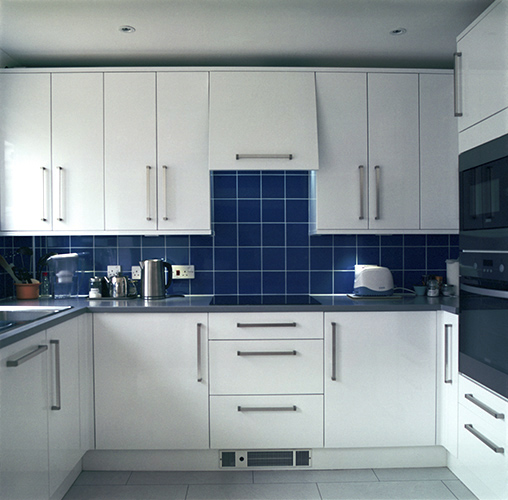
Pentax 67 55mm
- 100mm zoom lens set at 55mm. For more
information on this lens, see here.
[C582_13_55mm_Px67_lenss.jpg]
|
|
Pentacon Six coverage compared with Pentax 67
40mm – 45mm
| The
horizontal angle of view of the Pentax 67 camera
is obviously wider than the horizontal angle of
view of any 6×6 camera, including the Pentacon
Six. Here we repeat for easy side-by-side comparison the shots taken with the two 40mm lenses on the Pentacon Six and compare the horizontal coverage obtained with the Pentax 67 45mm lens when it is used on the Pentax 67. We can see that the horizontal angle of view of the Pentax 67 45mm lens is slightly wider than the horizontal angle of view of 40mm lenses when they are used on a Pentacon Six or other 6×6 camera. This is very impressive – provided that you are prepared and able to buy a Pentax 6×7, Pentax 67 or Pentax 67II camera. |
|
40mm Bronica
Zenzanon lens on the Pentacon Six
[C582_1-2_40mm_Zs.jpg]
|
|
40mm
Schneider-Kreuznach Curtagon lens on the
Pentacon Six
[C582_3_40mm_Cs.jpg]
|
|
45mm Pentax 67
lens on the Pentax 67II
[C583_2_45mms.jpg] |
|
| Obviously, as both the Pentacon Six and the Pentax 67 have the same vertical dimension for the film, even when the Pentax 67 45mm lens is used on the Pentax 67, it includes less height of the subject than either of the 40mm lenses. | |||||||
50mm – 55mm
| Here we compare the
horizontal angle of the 50mm Carl Zeiss Jena
Flektogon lens on the Pentacon Six with the
horizontal angle of the 55mm end of the Pentax
55-100mm zoom lens when it is mounted on the
Pentax 67II. We first repeat for easy side-by-side comparison the shot taken with the 50mm Flektogon lens. Again we see that the extra width of the film on the Pentax 67 means that more of the horizontal dimension of the subject is included when the 55mm lens is used on the Pentax 67II than is included horizontally on the Pentacon Six when using the 50mm Flektogon lens. Obviously, with both cameras having the same vertical dimension of the film gate, vertically the 55mm lens includes less than the 50mm lens. |
50mm Carl Zeiss
Flektogon lens on the Pentacon Six
[C582_7-8_50mm_Fleks.jpg] |
Pentax 67 55mm
- 100mm zoom lens set at 55mm on the Pentax 67II
[C583_3-4_55mms.jpg]
|
Linear distortion: curvature of straight lines
The best place to observe this in these images is the top of the units on the far wall, where the shadow between the units and the ceiling makes seeing the straightness or curvature of the line particularly easy.
Rank order from best to worst
Joint Firsts are:
Third Place:
These are the two
45mm Kiev 60 lenses from the Arsenal factory in
Kiev,
|
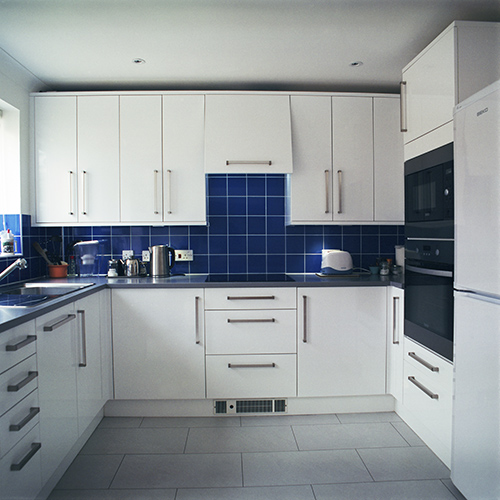 45mm MC Arsat B (= Mir 26Б) [C582_4-5_45mm_26Bs.jpg] |
 45mm Mir 69Б
[C582_6_45mm_69Bs.jpg] |
||||
Worst:
Chromatic Aberrations
It is probably the case that all lenses have some amount of chomatic aberrations, as each colour in the visible spectrum has a different wavelength and so correcting distortion equally for all colours is extremely difficult. However, at normal degrees of enlargement and from normal viewing distances this defect is often not obvious. However, in some lenses chromatic aberrations are reduced far more than in others, and we do observe some variations between these lenses.
The Good
The lens in this test with the least chromatic aberrations is probably the Pentax 67 45mm lens, with the 40mm Zenzanon and the 40mm Curtagon very close to it in quality. With the 50mm Flektogon, chromatic aberrations are very small, although the greater contrast delivered by this lens makes them more visible. At 55mm, the Pentax 67 55-100mm zoom lens shows virtually no chromatic aberrations, but it has very low contrast.
|
45mm Pentax 67
[C582_12_45mm_Px67_lens_CA.jpg]
|
40mm Bronica
Zenzanon
[C582_1-2_40mm_Z_CA.jpg] |
40mm Curtagon
[C582_3_40mm_C_CA.jpg]
|
|||||
| In this
section of the image taken with the 50mm Flektogon
lens, we see no chromatic aberrations in the
horizontal lines, but do see some in the vertical
lines. This becomes clearer because of the
fact that the Flektogon appears to deliver the
sharpest and most contrasty of the images seen
here. |
50mm Flektogon
[C582_7-8_50mm_Flek_CA.jpg] |
55-100mm Pentax
67 at 55mm
[C582_13_55mm_Px67_lens_CA.jpg] |
||||
The Less Good
The lens in this test with the most chromatic aberrations is the 55mm Arsat shift lens, followed by the 45mm Mir 26Б. The 45mm Mir 69Б has slightly less aberrations than the Mir 26Б.
|
55mm_Arsat
[C582_10-11_55mm_Arsat_CAs.jpg] |
45mm MC Arsat
(=Mir 26Б)
[C582_4-5_45mm_26B_CAs.jpg] |
45mm Mir 69Б
[C582_6_45mm_69B_CAs.jpg] |
In spite of the clear presence of chromatic aberrations with some of these lenses, studying the whole-frame images above, even when they are enlarged on a large screen, we observe that we do not notice these aberrations on most occasions. That is why I here call some results “less good”, but not “bad”.
Sharpness
When we examine small sections of these images massively enlarged in order to check for chromatic aberrations, we also observe that some lenses are less sharp than others. It is normal for sharpness to reduce as one moves nearer to the edge of images, and we have here selected a section that is quite near to the left-hand edge of the images and also not far from the tops of the images, in other words, not far from the top left-hand corner. All images were shot at f/8 in order to achieve a correct exposure at 1/30 second, without using a tripod. f/11 at 1/15 second would undoubtedly have given sharper images, but as we were not able to use a tripod on this occasion, this was not an option. Again, we repeat that we only noticed these variations when a tiny section of each image was massively enlarged. For normal use, normal degrees of enlargement and normal viewing distance, all of the lenses in this test produced images that were acceptably sharp or better.
Conclusion
Are the Pentax 67 lenses better than the equivalent Pentacon Six lenses? Yes and No!
Do the Pentax 67 lenses make a good contribution to the potential of the Pentacon Six? Yes!
Looking at the two Pentax 67 lenses reviewed on this page, are they better than the equivalent Pentacon Six lenses?
The 45mm Pentax 67 lens
Yes. It avoids the barrel distortion that is clearly visible at all image sizes with the Soviet Mir 26Б and Mir 69Б. It reduces massively the chromatic aberrations that become visible with larger image sizes when the Mir 26Б and Mir 69Б are used. It is also, for this focal length and format, quite a “small” lens.
The 55-100mm Pentax 67 lens at 55mm
No. The 50mm Flektogon is much better, with virtually no barrel distortion and much higher contrast than the Pentax lens.
However, the Pentax 55-100mm lens does offer something that is otherwise unavailable for the Pentacon Six: a wide-angle zoom. In less demanding situations than this current test, the 55-100mm Pentax 67 lens will make a valuable contribution to photography with the Pentacon Six.
We must also remember that Pentax offers for the Pentax 67 a 55mm fixed focal length lens. Such lenses are now commonly referred to as “prime” lenses. That lens has not been tested, but it is reasonable to assume that its performance will be better than that of the Pentax wide-angle zoom lens at 55mm.
